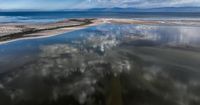When wildfires scorched neighborhoods across Los Angeles County this August, many residents glanced upward, expecting to see a haze of lingering smoke. Instead, the sky gleamed blue, and the Air Quality Index (AQI) numbers—those familiar color-coded signals of environmental safety—suggested the air was clean and healthy. But for many Angelenos, the story wasn’t so simple. Asthma flare-ups, scratchy throats, and other respiratory symptoms persisted, even as official monitors reported good to moderate air quality. This apparent contradiction has sparked new debate about what AQI numbers really mean, how air pollution is measured, and what steps are most effective for protecting public health in California’s most vulnerable regions.
In the Coachella and Imperial valleys, similar concerns are surfacing. For years, the focus has been on the Salton Sea, a shrinking inland lake whose exposed, dusty shoreline has long been blamed for the region’s poor air quality. California has poured nearly $49 million into dust suppression projects around the lake, covering more than 3,000 acres with salt-tolerant plants and gravel in hopes of reducing the amount of particulate matter wafting into nearby communities. But a new report released on August 14, 2025, by the Pacific Institute challenges that narrative. According to lead author Michael Cohen, dust from the Salton Sea’s expanding dry shore accounts for less than 1% of total small particle pollution in the region—a surprisingly small fraction, given the scale of investment and concern.
“My big takeaway is that there’s so many different sources that what we really need to do is pivot away from source control to start protecting people where they’re exposed,” Cohen told Los Angeles Times. The data, drawn from local, state, and federal agencies, paints a complex picture: pollution in the region comes from a tangled mix of agricultural chemicals, manure from livestock, diesel exhaust, unpaved roads, and even fine debris from lithium mining. The Salton Sea, while visible and dramatic, is just one piece of a much larger puzzle.
The region’s geography doesn’t help. The Salton Sea Basin, Coachella Valley, and Imperial Valley all violate ozone limits, and the Imperial Valley and Salton Sea Basin have, on average, twice the state limit for larger particles. Since 2018, the Salton Sea has stopped receiving fresh water inflow—now, only agricultural runoff feeds the lake. As a result, it’s evaporating and shrinking, exposing even more dry lake bed that can contribute to airborne dust. Wind patterns, especially strong gusts, can sweep across the lake bed and surrounding farmland, kicking up toxic particles and carrying them into nearby towns. Many of these communities are predominantly Latino or Indigenous, adding an environmental justice dimension to the problem.
It’s a public health crisis with real human costs. A 2023 survey by the UC Riverside School of Medicine found that more than one in five children living near the Salton Sea have asthma—nearly twice the state average. Almost 29% of parents reported their child had experienced wheezing or breath whistling in the past year, most within the last 12 months. “We’ve been noticing an uptick … of asthma-related … emergencies, people having nosebleeds, people having migraines, people feeling dizzy, nauseous,” said Aydee Rodriguez, environmental justice campaign manager for the nonprofit Alianza Coachella Valley.
Despite these alarming numbers, the new research suggests that focusing solely on outdoor dust suppression may be missing the mark. Cohen and his colleagues argue that investing in measures to protect people indoors—such as distributing air filters, weatherizing homes, and issuing timely alerts to stay inside during poor air quality—could be more cost-effective and impactful. “It’s just much more effective, more cost-effective to switch to exposure control ... because really, at the end of the day, we’re trying to protect public health and improve the lives of people,” Cohen emphasized.
But not everyone is convinced that shifting focus away from outdoor air quality is the right move. “A tiny amount of toxic material, even if it’s infinitesimally small, can still have really major health effects,” cautioned Dr. David Lo, a UC Riverside professor specializing in air pollution. And Rodriguez worries that prioritizing indoor air quality could leave many residents unprotected, especially those who can’t afford air purifiers or live in homes that are difficult to seal against outdoor pollutants.
Meanwhile, in Los Angeles County, the recent fires have exposed a different kind of gap in air quality monitoring. The AQI, a tool developed by the Environmental Protection Agency (EPA) to communicate outdoor air quality, is based on measurements of criteria air pollutants such as PM2.5 (fine particulate matter) and ozone. An AQI value of 50 or below is considered good, while anything above 100 is unhealthy. But as Lung-Wen Antony Chen, an associate professor at the University of Nevada, Las Vegas School of Public Health, explained to Yahoo Life, “while high AQI would certainly indicate an unsafe condition, a low AQI does not guarantee healthy air quality.”
Why? For one, the AQI doesn’t include hazardous air pollutants (HAPs)—chemicals that are usually present in lower concentrations but are much more toxic. The EPA has a separate monitoring program for HAPs, but this data is not reflected in the AQI. Additionally, the AQI averages pollutant levels over specified time windows (for PM2.5, a 24-hour average), which can mask short-term spikes in pollution—like those caused by wildfire smoke plumes that may only last a few hours but can have acute health impacts.
“The AQI can’t tell us about very localized air pollution,” noted Shahir Masri, an air pollution exposure specialist at UC Irvine. A small factory or busy road near your home can cause elevated exposures that won’t show up on regional monitors. And while regulatory-grade air monitors are highly calibrated, the proliferation of low-cost sensors like PurpleAir and Atmotube has made it possible for individuals to track real-time PM2.5 levels in their own neighborhoods. These devices, available for around $179 to $209, have been validated for accuracy and can offer a more granular view of local air quality.
For those concerned about protecting their health—especially sensitive groups like children, seniors, pregnant people, and those with respiratory or heart conditions—experts recommend a mix of strategies. Stay indoors during periods of poor air quality, seal windows and doors, use HEPA air purifiers, avoid activities that stir up dust, wear high-quality masks like N95s if venturing outside, and keep air vents clean. And if you’re experiencing symptoms like difficulty breathing, it’s always wise to consult a medical provider.
As California continues to grapple with the twin challenges of environmental degradation and public health, the message from researchers is clear: there’s no single solution. Tackling air pollution requires a nuanced approach that combines outdoor mitigation, indoor protection, and robust public information. As Cohen put it, “My hope is that the people start to get together and start talking to each other—about what the different agencies are doing, where they’re investing their money and how they can leverage and optimize those investments in public health.”
In the end, the quest for clean air in California is as complex and dynamic as the state itself. While blue skies may look reassuring, the invisible threats demand vigilance, innovation, and, above all, a commitment to protecting the most vulnerable among us.




